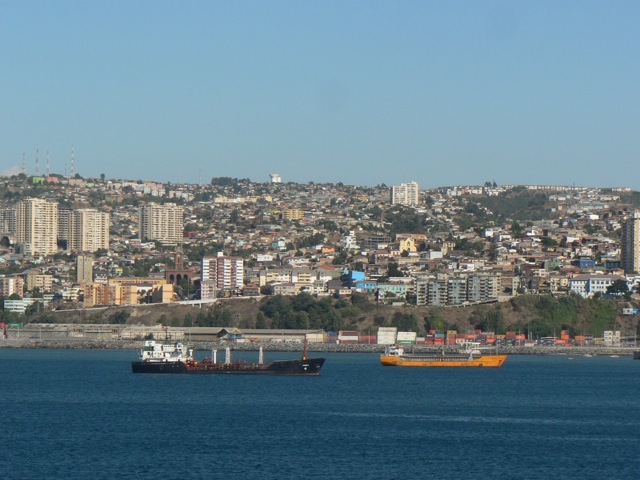
Guest bloggers Russ and Susan Rosenberry are owners of Islands in the Sun Cruises and Tours. You can find the original blog from their 2008 cruise around South American here, or visit the company’s website at www.crus-sun.com.
Dec. 6 — Flights on Copa Airlines from Miami to Santiago (via Panama City) were punctual and smooth, and with decent service. Chile’s time zone is 2 hours ahead of Eastern Standard time, and at this time of year daylight lasts until after 9:00 pm. Santiago is located in the ‘Central Valley’ in central Chile and views of the (often snowcapped) Andes Mountains provide a picturesque backdrop and easy directional landmark. After clearing customs and immigration our transfer to our Santiago hotel took about 20 minutes. We quickly settled in, and then took a taxi to a nearby restaurant noted for its ‘seafood’ ““ Porto Fuy ““ Russ had the best Sea Bass and Mushroom Soup ever, and we enjoyed a crisp Chilean Sauvignon Blanc from the Casablanca Valley. US dollars are widely accepted for tips and taxis, and of course credit cards at other establishments. Most Chileans have very limited English skills, except for those directly involved in tourism or other selected industries.
Dec. 7 — In late spring sunrise in Santiago is also early, so after a breakfast buffet at the hotel, our tour guide and driver were ready to show us the highlights of their capital city. Santiago is a collection of many neighborhoods, each with their own government and mayor. It is also a mixture of many historical buildings in various states of renewal or decay, as well as many very modern buildings brought forth during the last decade or so of a fairly robust and stable economy. We first concentrated on the central part of the city, which was founded by Pedro de Valdivia in 1541. Plaza de Armas was the site of the original development and it is still a busy meeting point for locals and visitors. It now contains many trees, including the stately Chilean Palm, fountains, sidewalks and seating areas as well as an imposing statue of the mounted Valdivia. The square is now surrounded by many historical buildings such as the 1747 version of the Santiago Cathedral, the National Historical Museum inaugurated in 1808, and a beautifully restored ‘turn of the century’ Correo Central (1902) which still serves as a post office. Another key landmark nearby is the Presidential Palace, ‘La Moneda’ originally built in 1788. The President of Chile no longer lives in the Palace, but the executive offices are housed there. Every other day a formal ‘changing of the guard’ ceremony takes place here, complete with military marching band, horses, and intricate colorguard formations. The Palace has been restored from being severely destroyed during the military coup of 1973 when the Chilean Airforce actually bombed the Palace to end the leftist government of Salvadore Allende, who then alledgedly committed suicide. Chilean politics has had many other colorful leaders throughout its history, and currently has a woman President (despite Chilean women only having the right to vote since 1949). Many other restored historical buildings in Santiago are now used as buildings for Santiago’s many universities.
Other neighborhoods of interest to tourists highlight include the Mercado Central (Central Market) filled with restaurants and shops, the ‘Bohemian’ neighborhood of Bellavista, and the artisan market in Las Domenicas, and many, many more. And on a sunny and clear day, a visit to the top of Cerro San Cristobal via road, cable car or funicular awards you a beautiful panoramic view of Santiago and the thriving central valley. An imposing statue of the Shrine of the Virgin Mary, built in 1908 reigns over the hillside and is lit up at night. The Catholic Church still plays a strong role in the life of Chile.
Dec. 8 — A scenic journey from Santiago to the coastal towns of Vino del Mar and Valparaiso is made easy by Chile’s great highway system. Vino del Mar is an upscale beach resort town that is currently booming with many new hotels and condominiums sprouting up. Luxury shopping centers and casinos abound as well. The climate and terrain are very reminiscent of southern California. About 20 minutes south on the coast is the port city of Valparaiso ““ where cruise ships, container ships, and the Chilean Navy are based. In the 19th century it was named ‘little San Francisco’ and was a thriving port where most ships that rounded Cape Horn made a port call. Then after the Panama Canal was opened in 1914 this business greatly dwindled and the city went into decline. In recent years the tourism industry has begun to help this charmingly situated city regain some of its former stature.
It is a secure and easy port to access, and provides great views for an amazing ‘sailaway’.










